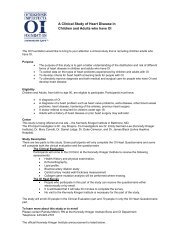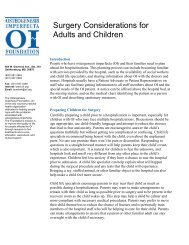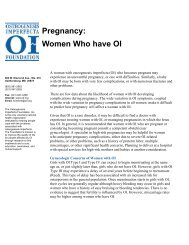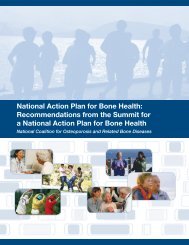Breakthrough - Osteogenesis Imperfecta Foundation
Breakthrough - Osteogenesis Imperfecta Foundation
Breakthrough - Osteogenesis Imperfecta Foundation
You also want an ePaper? Increase the reach of your titles
YUMPU automatically turns print PDFs into web optimized ePapers that Google loves.
Article<br />
How do we estimate the number of people with OI?<br />
Available statistics regarding the<br />
number of people with OI are estimates,<br />
not exact figures. It is estimated<br />
that 30,000 to 50,000 people in<br />
the United States have OI. This<br />
estimate is an “educated guess” based<br />
in part on studies done in other countries,<br />
where smaller populations and<br />
the existence of centralized OI registries<br />
make it more feasible for researchers<br />
to count the number of<br />
people affected. OI Type I is by far<br />
the most common form of OI; researchers<br />
estimate that 50 to 60<br />
percent of people with OI have this<br />
form of the disorder.<br />
Scientists who study diseases in<br />
populations use “incidence” and<br />
“prevalence” to measure how often a<br />
disease or disorder occurs. Incidence<br />
means the number of new cases of a<br />
disease or disorder in the population<br />
during a given period. For genetic<br />
disorders such as OI, incidence usually<br />
refers to the number of babies born<br />
each year with the disorder.<br />
Prevalence refers to the number of<br />
people of all ages who have a disease<br />
or disorder at a designated time. When<br />
people ask, “How many people in the<br />
U.S. have OI?” they are asking about<br />
the prevalence of OI, not the incidence.<br />
A more precise estimate of OI<br />
incidence or prevalence in the U.S.<br />
would require a comprehensive<br />
population study. Such a study would<br />
have to inquire about the number of<br />
cases of OI occurring in a large group<br />
of people who are representative of<br />
the wider population in terms of<br />
gender, race, ethnicity, geography, etc.<br />
This type of study has not been done in<br />
the United States due to health privacy<br />
issues and the immense cost.<br />
Alternatively, a study could attempt<br />
to locate—to actually count—every<br />
person in the country who has been<br />
diagnosed with OI. This type of<br />
study’s utility as a precise counting tool<br />
is limited. How does one reach everyone?<br />
Researchers could try to locate<br />
people with OI by contacting doctors,<br />
hospitals, and clinics where people<br />
might go for treatment, but health<br />
privacy laws would limit the<br />
physician’s response. It would also be<br />
extremely difficult to reach people with<br />
OI who are unaffiliated with any OIrelated<br />
organization or treatment<br />
facility, including those with very mild<br />
OI who remain undiagnosed their<br />
entire lifetime.<br />
Gathering data on the incidence or<br />
prevalence of OI is difficult because of<br />
the variable nature of OI. Though<br />
more severe cases of OI are usually<br />
apparent at (or before) birth, many<br />
people with OI are not diagnosed until<br />
later in life. When babies are stillborn<br />
as a result of the most severe type of<br />
OI, it may not be recorded as the<br />
official cause of death. Therefore,<br />
even if a comprehensive effort was<br />
made to determine how many babies<br />
are born with OI, many cases of OI<br />
would still be missed. Likewise, it is<br />
not uncommon for an adult with mild<br />
OI to be unaware of having the<br />
disorder. Even the most rigorous and<br />
far-reaching study might miss a<br />
significant number of people with OI.<br />
To try to estimate prevalence, based<br />
on incidence, a study would have to be<br />
MAKE new friends in the OI Community...<br />
created that would ensure the measurement<br />
of incidence was complete.<br />
You would then need to know the<br />
life expectancy of those born with the<br />
disorder, which varies greatly due to<br />
the variability of the disorder. It’s<br />
simply not possible to accurately<br />
measure the prevalence of OI in the<br />
U.S.<br />
Therefore we continue to use the<br />
30,000 to 50,000 number, which is<br />
based on the most accurate incidence<br />
and prevalence figures from smaller<br />
countries with socialized medicine and<br />
current OI registries. That data is<br />
compared to U.S. population figures<br />
and the limited hard data we do have<br />
available about OI in the U.S. to<br />
extrapolate our current estimate.<br />
OI is often considered a rare disorder.<br />
The National Organization for<br />
Rare Disorders defines a rare disorder<br />
as one that affects fewer that 200,000<br />
people in the United States.<br />
While OI certainly qualifies under<br />
their definition, it helps to put the<br />
estimated number into perspective by<br />
comparing it to recent estimates from<br />
other disorders. It is estimated that:<br />
· 200,000 to 250,000 people in the<br />
U.S. have multiple sclerosis, a progressive<br />
neurological disorder (source:<br />
National Multiple Sclerosis Society),<br />
· 40,000 people in the U.S. have<br />
Marfan Syndrome, a connective tissue<br />
disorder affecting the heart and other<br />
organs (source: National Marfan<br />
<strong>Foundation</strong>), and<br />
· Cystic Fibrosis affects approximately<br />
30,000 children and young adults in the<br />
U.S. (Source: Cystic Fibrosis <strong>Foundation</strong>).<br />
...by joining us each Sunday at 8 p.m. EST on www.oif.org for the OI <strong>Foundation</strong>’s online chats.<br />
MEET new friends at the National Conference<br />
June 24-26,2004, in Dallas, TX!<br />
Page 7 <strong>Breakthrough</strong> Winter 2004
















